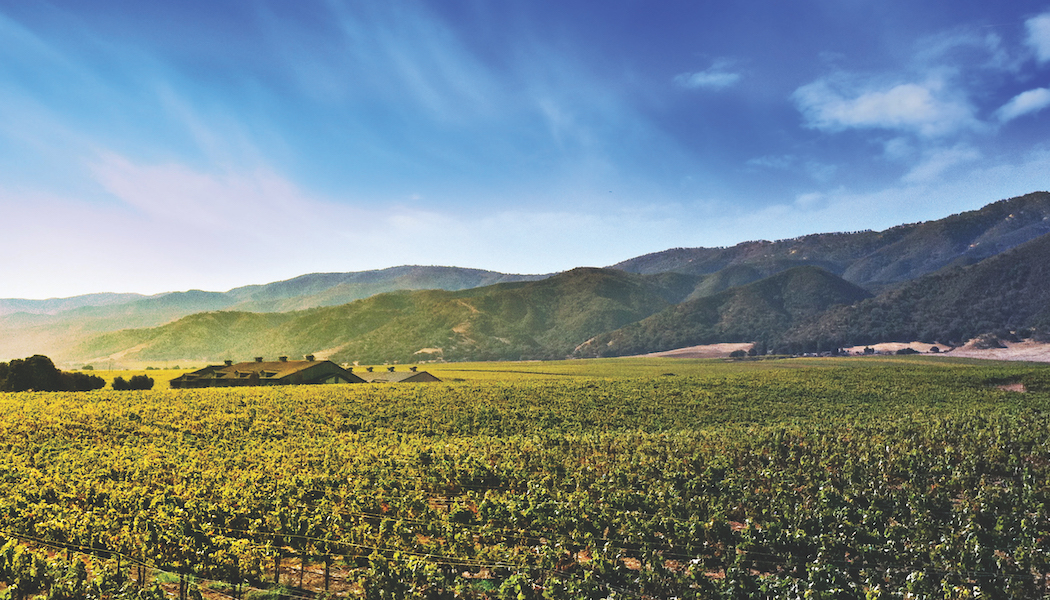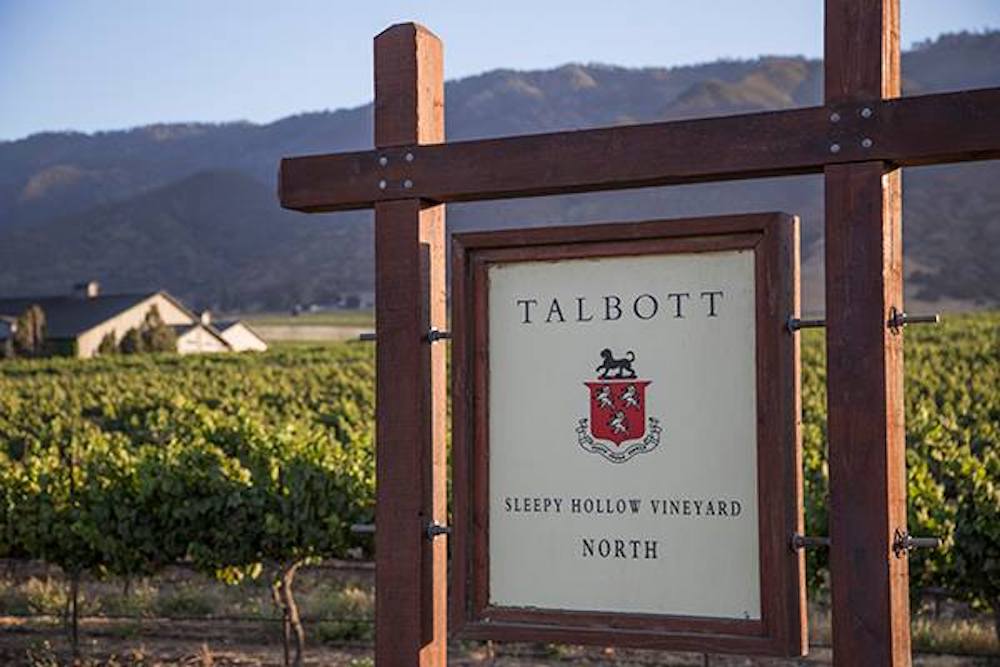
Sleepy Hollow Vineyard - Caretaking a Grand Cru Treasure
Edible Monterey Bay
Laura Ness
7/22/2022
Talbott’s Sleepy Hollow Vineyard: Caretaking a Grand Cru Treasure
by Laura Ness
July 22, 2022 – When the Santa Lucia Highlands Somm Tour visited Talbott’s Sleepy Hollow Vineyard for lunch and a tour last week we were greeted by Chris Munsell, senior director of winemaking at E. & J. Gallo Winery. He’s gregarious, quick-witted and knowledgeable, all the things you want when you are the face of a cherished brand. And it’s abundantly clear that Gallo considers Talbott a premium brand deserving of investment.

It was mighty odd for me not to see the smiling face of former Talbott winemaker David Coventry, who left Talbott in May after a five-year stint following Gallo’s purchase of the brand and the Sleepy Hollow Vineyard from Robb Talbott. Prior to that, I was used to visiting with winemaker Dan Karlsen, whose stories roll out one after the other like tomes off a printing press. The place felt bizarrely quiet, to be honest. Munsell says they are planning to fill Coventry’s position, which gives some hope that the robust Block program instituted on his watch will continue.
Meanwhile, Talbott has a great brand ambassador in Tyler Menane, who manages the tasting room in Carmel. He has the Talbott story down, and is well-versed and enthusiastic about all the wines, including what’s still left in the library. Hint: not so much. As for the future, he tipped us off to a few new things Talbott has up its proverbial sleeve. More on that below.
After tasting the 2018 Sleepy Hollow Chardonnay with its warm peach cobbler notes and the 2018 Sleepy Hollow Pinot Noir, exuding the generosity of ripeness from a very even vintage across the board, we were treated to the 2019 Fidelity Pinot Noir, a whole other level of winemaking and attention to the tiny bits that make a good wine attain greatness.
This is special stuff, elegant, poised and wearing its silky red raspberry cloak with a flair of embroidered floral detail. A great wine doesn’t lounge laconically on a couch like a cat who could care less whether you paid it heed; instead, it’s like a Jack Russell terrier, poking you with a paw or two, fully convinced it deserves your undivided attention. You just can’t help but want to take another sip.
After lunch we visited the famed 565-acre vineyard that was planted back in 1972 by Jerry McFarland, who grew up farming crops like potatoes and table grapes in the Central Valley. Arriving as a freshman at UC Davis, he was smitten by the idea of finding the perfect place to grow Burgundian varieties. After gathering much weather data, he determined that a spot at the northern end of River Road would work. He started a trend by planting Chardonnay and Pinot Noir, when everyone else was trying to grow Bordeaux varieties. And the legend of Sleepy Hollow—the West Coast edition—was born.
Talbott, the wine brand, was established in 1982 by tie maker Robb Talbott, who fell in love with everything about Burgundy while buying silk fabric in France. He named the first wines after his children, Kali Hart and Logan, eventually growing production to the point where he needed more fruit. In 1994, he purchased Sleepy Hollow from Jerry McFarland and proceeded to put what is today considered one of America’s Grand Cru vineyards on the map. Talbott became a brand synonymous with amazingly priced Chardonnay and Pinot Noir that you could reliably find in the grocery store. And, if you wanted something upscale, they had that, too, in several beautifully packaged permutations. This vineyard helped define affordable American Burgundy from Monterey County for at least two generations of consumers. It also helped spawn the growth of this region as a standout producer of Chardonnay and Pinot Noir known the world over as the Santa Lucia Highlands.
After Gallo purchased the vineyard they began replanting the vineyard, with significant input from Coventry, who started in 2016. After 44 years, the old Martini and Wente clones were beginning to fade. The old Pinot Noir vines were replaced with clones 667, 777, 115 and Pommard, while the Wente Clone 4 of Chardonnay, gave way to Clone 95.
When Gallo took over the vineyard was 2/3 Chardonnay and 1/3 Pinot Noir. The latter was planted at the bottom of the vineyard where it lagged behind at harvest. Putting Pinot Noir, in particular, clones 115 and 667, at the upper part of the bench where it tends to have a leaner set and provide more concentration, helps it to ripen, but also to retain a prized floral component. Chardonnay is an easier adapter, so it does fine on that lower part, where it ripens a little later.
Munsell took us halfway up the Sleepy Hollow West Vineyard bench to Block 22, which he described as an older vineyard with great clones. “It’s an example of how we use the vineyard to our benefit. We have hand picked the clones to be beneficial to the overall Talbott style. We use Dijon clones for mouthfeel. Clone 115 is particularly known for its rose petal aromas and silky mid-palate.” He explained that the 2019 Fidelity we tasted earlier was sourced from Block 23, where clones 113, 115 and 667 are predominant. For vintage 2021, Fidelity was sourced from Block 22, which we would try upon returning to the winery. The bus took us past Block 4, which is all Chardonnay, and from which the Fidelity Chardonnay was made in 2019. Some of the vines looked to be struggling. There’s no end of gophers, alas. Too bad they’re stringy.
Back at the winery, we barrel-sampled the 2021 Block 4 Chardonnay from a Francois Frere M+ barrique, appreciating its open knit texture, ripe orchard fruit, with lots of pear and apple and a dollop of butterscotch along with some lemon butter for complexity. This will be a lovely wine. The 2019 Block 4 Chardonnay showed a bit more concentration, as one would expect from additional barrel and bottle aging, delivering up peach and apple pie.
The 2021 Pinot Noir barrel sample from Block 22 was all clone 115, resting in a Francois Frere M+ 3-year air dried barrique. As Munsell promised, it not only jumped out of the glass with its sweet rose petal perfume, but it also sported cranberry and raspberry, a combination he referred to as “pinosity,” the essence of Pinot Noir. We could hardly disagree.
Back to what’s coming down the pike from Talbott, according to Ty Menane. He says they made their first rosé ever in 2021, 90% Pinot Noir and 10% Chardonnay, and released it in March to the tasting room: it sold out immediately. They’ve also been working on a sparkling, a true 50/50 Brut, which will be released on August 27 at the Carmel tasting room, accompanied by caviar and crème fraiche.
In addition, they have a low alcohol Chardonnay, clocking in at 9.8%, which will be released sometime this year. A low alcohol Pinot Noir also waits in the wings and will hit the street in 2023. I’ve not tried either of them, so must withhold judgment.
After recently tasting way too many examples of near zero canned wines clocking in at well under 1% alcohol, I will just say, just because you can, doesn’t mean you should. I’m pretty sure stripping all the alcohol out of a wine after it has been fermented, is cause for every single yeast organism on the planet to question our collective sanity.
Talbott’s Sleepy Hollow Vineyard: Caretaking a Grand Cru Treasure 
by Laura Ness
July 22, 2022 – When the Santa Lucia Highlands Somm Tour visited Talbott’s Sleepy Hollow Vineyard for lunch and a tour last week we were greeted by Chris Munsell, senior director of winemaking at E. & J. Gallo Winery. He’s gregarious, quick-witted and knowledgeable, all the things you want when you are the face of a cherished brand. And it’s abundantly clear that Gallo considers Talbott a premium brand deserving of investment.
It was mighty odd for me not to see the smiling face of former Talbott winemaker David Coventry, who left Talbott in May after a five-year stint following Gallo’s purchase of the brand and the Sleepy Hollow Vineyard from Robb Talbott. Prior to that, I was used to visiting with winemaker Dan Karlsen, whose stories roll out one after the other like tomes off a printing press. The place felt bizarrely quiet, to be honest. Munsell says they are planning to fill Coventry’s position, which gives some hope that the robust Block program instituted on his watch will continue.
Meanwhile, Talbott has a great brand ambassador in Tyler Menane, who manages the tasting room in Carmel. He has the Talbott story down, and is well-versed and enthusiastic about all the wines, including what’s still left in the library. Hint: not so much. As for the future, he tipped us off to a few new things Talbott has up its proverbial sleeve. More on that below.
After tasting the 2018 Sleepy Hollow Chardonnay with its warm peach cobbler notes and the 2018 Sleepy Hollow Pinot Noir, exuding the generosity of ripeness from a very even vintage across the board, we were treated to the 2019 Fidelity Pinot Noir, a whole other level of winemaking and attention to the tiny bits that make a good wine attain greatness.
This is special stuff, elegant, poised and wearing its silky red raspberry cloak with a flair of embroidered floral detail. A great wine doesn’t lounge laconically on a couch like a cat who could care less whether you paid it heed; instead, it’s like a Jack Russell terrier, poking you with a paw or two, fully convinced it deserves your undivided attention. You just can’t help but want to take another sip.
After lunch we visited the famed 565-acre vineyard that was planted back in 1972 by Jerry McFarland, who grew up farming crops like potatoes and table grapes in the Central Valley. Arriving as a freshman at UC Davis, he was smitten by the idea of finding the perfect place to grow Burgundian varieties. After gathering much weather data, he determined that a spot at the northern end of River Road would work. He started a trend by planting Chardonnay and Pinot Noir, when everyone else was trying to grow Bordeaux varieties. And the legend of Sleepy Hollow—the West Coast edition—was born.
Talbott, the wine brand, was established in 1982 by tie maker Robb Talbott, who fell in love with everything about Burgundy while buying silk fabric in France. He named the first wines after his children, Kali Hart and Logan, eventually growing production to the point where he needed more fruit. In 1994, he purchased Sleepy Hollow from Jerry McFarland and proceeded to put what is today considered one of America’s Grand Cru vineyards on the map. Talbott became a brand synonymous with amazingly priced Chardonnay and Pinot Noir that you could reliably find in the grocery store. And, if you wanted something upscale, they had that, too, in several beautifully packaged permutations. This vineyard helped define affordable American Burgundy from Monterey County for at least two generations of consumers. It also helped spawn the growth of this region as a standout producer of Chardonnay and Pinot Noir known the world over as the Santa Lucia Highlands.
After Gallo purchased the vineyard they began replanting the vineyard, with significant input from Coventry, who started in 2016. After 44 years, the old Martini and Wente clones were beginning to fade. The old Pinot Noir vines were replaced with clones 667, 777, 115 and Pommard, while the Wente Clone 4 of Chardonnay, gave way to Clone 95.
When Gallo took over the vineyard was 2/3 Chardonnay and 1/3 Pinot Noir. The latter was planted at the bottom of the vineyard where it lagged behind at harvest. Putting Pinot Noir, in particular, clones 115 and 667, at the upper part of the bench where it tends to have a leaner set and provide more concentration, helps it to ripen, but also to retain a prized floral component. Chardonnay is an easier adapter, so it does fine on that lower part, where it ripens a little later.
Munsell took us halfway up the Sleepy Hollow West Vineyard bench to Block 22, which he described as an older vineyard with great clones. “It’s an example of how we use the vineyard to our benefit. We have hand picked the clones to be beneficial to the overall Talbott style. We use Dijon clones for mouthfeel. Clone 115 is particularly known for its rose petal aromas and silky mid-palate.” He explained that the 2019 Fidelity we tasted earlier was sourced from Block 23, where clones 113, 115 and 667 are predominant. For vintage 2021, Fidelity was sourced from Block 22, which we would try upon returning to the winery. The bus took us past Block 4, which is all Chardonnay, and from which the Fidelity Chardonnay was made in 2019. Some of the vines looked to be struggling. There’s no end of gophers, alas. Too bad they’re stringy.
Back at the winery, we barrel-sampled the 2021 Block 4 Chardonnay from a Francois Frere M+ barrique, appreciating its open knit texture, ripe orchard fruit, with lots of pear and apple and a dollop of butterscotch along with some lemon butter for complexity. This will be a lovely wine. The 2019 Block 4 Chardonnay showed a bit more concentration, as one would expect from additional barrel and bottle aging, delivering up peach and apple pie.
The 2021 Pinot Noir barrel sample from Block 22 was all clone 115, resting in a Francois Frere M+ 3-year air dried barrique. As Munsell promised, it not only jumped out of the glass with its sweet rose petal perfume, but it also sported cranberry and raspberry, a combination he referred to as “pinosity,” the essence of Pinot Noir. We could hardly disagree.
Back to what’s coming down the pike from Talbott, according to Ty Menane. He says they made their first rosé ever in 2021, 90% Pinot Noir and 10% Chardonnay, and released it in March to the tasting room: it sold out immediately. They’ve also been working on a sparkling, a true 50/50 Brut, which will be released on August 27 at the Carmel tasting room, accompanied by caviar and crème fraiche.
In addition, they have a low alcohol Chardonnay, clocking in at 9.8%, which will be released sometime this year. A low alcohol Pinot Noir also waits in the wings and will hit the street in 2023. I’ve not tried either of them, so must withhold judgment.
After recently tasting way too many examples of near zero canned wines clocking in at well under 1% alcohol, I will just say, just because you can, doesn’t mean you should. I’m pretty sure stripping all the alcohol out of a wine after it has been fermented, is cause for every single yeast organism on the planet to question our collective sanity.
Read at Edible Monterey Bay here.


